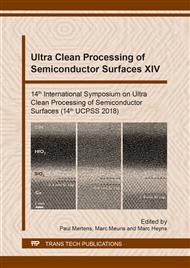p.226
p.232
p.238
p.244
p.250
p.256
p.263
p.268
p.273
Optimization of Wet Strip for Metal Void Reduction in Trench First Metal Hard Mask Back End of Line Process
Abstract:
The purpose of this paper is to study the effects of wet strip clean for metal void reduction in trench first metal hard mask back end of line (BEOL) integration process in 14 nm Technology. A thicker TiN film is becoming important to resolve via-metal short yield and time-dependent dielectric breakdown (TDDB) issues caused by the Litho-Etch-Litho-Etch (LELE) misalignment due to smaller patterning features. This brings the multitude of advanced integration technology need for complete TiN hard mask (HM) removal, post etch residue removal, ultra low-k dielectric (ULK) and Cu stability, interconnect resistance, and continuing high volume manufacturing (HVM) cost challenges together with environmental concerns and the waste handling/treatment cost. At GlobalFoundries, we achieved a wet strip clean process with a 45 % lower cost of ownership (CoO) while maintaining the TiN HM removal rate, baseline critical dimension (CD), normalized defect density (DOI), the ULK and Cu stability, via resistance, and yield.
Info:
Periodical:
Pages:
250-255
Citation:
Online since:
August 2018
Authors:
Keywords:
Price:
Сopyright:
© 2018 Trans Tech Publications Ltd. All Rights Reserved
Share:
Citation:


